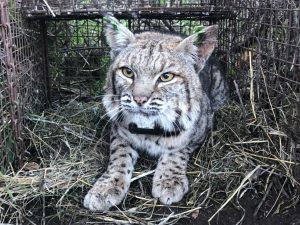Two more wild cats killed by rodenticides

The National Park Service (NPS) announced that a juvenile mountain lion and adult bobcat have died from rodenticides (anti-rodent poisons, often just called “rat poison”). The wild cats did not ingest the poisons directly, but ate smaller animals that had eaten the poison and were thus sickened, making them easier to catch, or killed. These poisons persist in the rodents (mice, rats, squirrels) and are passed along to any animals that consume them in turn, unintentionally poisoning larger carnivores.
Not only are wild cats killed by these poisons, but also foxes, coyotes, birds of prey such as owls and hawks, and pet dogs and cats.
 The bobcat (pictured) was collared in January and denoted B-372, but was found dead in June in Agoura Hills where it had spent much of it’s time. According to the NPS, bobcats don’t normally live in neighborhoods, but the nearby open space areas had been decimated by the November 2018 Woolsey Fire. Tests showed that B-372 contained several different rodenticide poisons in its system.
The bobcat (pictured) was collared in January and denoted B-372, but was found dead in June in Agoura Hills where it had spent much of it’s time. According to the NPS, bobcats don’t normally live in neighborhoods, but the nearby open space areas had been decimated by the November 2018 Woolsey Fire. Tests showed that B-372 contained several different rodenticide poisons in its system.
These rodenticides are anticoagulants – chemicals that prevent the blood from clotting. Small bruises and scrapes that would normally heal quickly can lead to an animal bleeding to death. All animals, including people, constantly sustain slight internal injuries that normally heal and go unnoticed. Rodenticides can cause animals to bleed to death internally. This is what killed B-372.
Bobcat rodenticide poisonings are extremely rare. The NPS has been studying bobcats in the Santa Monica Mountains National Recreation Area (SMMNRA) for 24 years but this is only the second to have been found so poisoned. Although about 90% of bobcats tested after death have rodenticides in their system, normally they don’t have internal bleeding. Instead, a strong association has been found between the level of rodenticides and a fatal mange disease, possibly because of effects on the immune system.
Bobcats are quite common in the SMMNRA compared to mountain lions, also known as pumas or cougars. We have only a few mountain lions in the Santa Monica Mountains and surrounding areas. As such, loss of a single animal can have a significant impact on the genetic makeup of the population as a whole.
The young mountain lion designated P-76 was captured and collared in the San Fernando Valley in November 2019. It was found dead less than three months later in the Santa Susana Mountains north of the 118 freeway. Like B-372, it was killed as a result of internal bleeding, and was found to have five different anticoagulant rodenticide poisons in its body. It is the sixth collared mountain lion to die from rat poisons and the third in the past two years.
Homeowners and neighborhoods use rodenticides to try to reduce the number of unwanted rodents (mice, rats and squirrels). Ironically, by poisoning and killing prey animals, they are eliminating the animals that normally keep rodent numbers low, resulting in an increase in the number of unwanted rodents, and the subsequent use of more and more rodenticide poisons to deal with them.
The sale of so-called second generation rodenticides to individuals has been banned in California since 2014, but they can still be used on farms and by professional exterminators. Also, a number of jurisdictions have passed resolutions discouraging the use of rodenticides, including Malibu, Calabasas, Moorpark, Agoura Hills, Ojai, Hidden Hills, Ventura County, Westlake Village, Simi Valley, Thousand Oaks and Camarillo.
The best way to deal with rodents is the old-fashioned spring trap. They are effective and dispatch the animals very quickly.
Read the complete press release about these wild cat poisonings from the NPS.



0 Comments